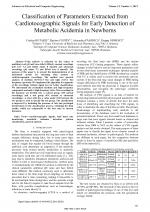| 3/2015 - 23 | View TOC | « Previous Article | Next Article » |
Classification of Parameters Extracted from Cardiotocographic Signals for Early Detection of Metabolic Acidemia in NewbornsROTARIU, C. |
| Extra paper information in |
| Click to see author's profile in |
| Download PDF |
Author keywords
cardiotocographic signals, fetal heart rate monitoring, metabolic acidemia detection, pattern classification, spectral analysis
References keywords
fetal(16), rate(10), heart(10), neonatal(6), analysis(5), prediction(4), obstretics(4), monitoring(4), gynecology(4)
No common words between the references section and the paper title.
About this article
Date of Publication: 2015-08-31
Volume 15, Issue 3, Year 2015, On page(s): 161 - 166
ISSN: 1582-7445, e-ISSN: 1844-7600
Digital Object Identifier: 10.4316/AECE.2015.03023
Web of Science Accession Number: 000360171500023
SCOPUS ID: 84951088832
Abstract
Fetal acidosis is reflected by the values of umbilical cord pH and base deficit (BDecf): normal recordings (pH over 7.2 and BDecf under 8 mmol/l) and abnormal recordings (pH under 7.2 and BDecf over 8 mmol/l). The purpose of this paper is to present the implementation of an automated system for detecting fetal acidosis in cardiotocographic recordings. The method uses spectral analysis of medium (0.07-0.13 Hz) and high (0.13-1 Hz) frequency spectrum. We implement the algorithm for segments of the recordings without signal loss for better classification. We determined the normalized medium and high frequency components and mid to high frequency ratio. The recordings in the database are divided into a control group (100 normal recordings) and a test group (431 normal or abnormal recordings). A t-test with the p value under 0.05 between the two groups is used to classify the test group. The classification is improved by including the presence of late and prolonged decelerations in the classification process, obtaining the final results, which are comparable to the best ones in current literature. |
| References | | | Cited By |
Web of Science® Times Cited: 3 [View]
View record in Web of Science® [View]
View Related Records® [View]
Updated today
SCOPUS® Times Cited: 2
View record in SCOPUS® [Free preview]
View citations in SCOPUS® [Free preview]
[1] Antepartum Fetal Monitoring and Spectral Analysis of Preterm Birth Risk, Păsăricără, Alexandru, Nemescu, Dragoş, Arotăriţei, Dragoş, Rotariu, Cristian, Journal of Physics: Conference Series, ISSN 1742-6588, Issue , 2017.
Digital Object Identifier: 10.1088/1742-6596/931/1/012009 [CrossRef]
Disclaimer: All information displayed above was retrieved by using remote connections to respective databases. For the best user experience, we update all data by using background processes, and use caches in order to reduce the load on the servers we retrieve the information from. As we have no control on the availability of the database servers and sometimes the Internet connectivity may be affected, we do not guarantee the information is correct or complete. For the most accurate data, please always consult the database sites directly. Some external links require authentication or an institutional subscription.
Web of Science® is a registered trademark of Clarivate Analytics, Scopus® is a registered trademark of Elsevier B.V., other product names, company names, brand names, trademarks and logos are the property of their respective owners.
Faculty of Electrical Engineering and Computer Science
Stefan cel Mare University of Suceava, Romania
All rights reserved: Advances in Electrical and Computer Engineering is a registered trademark of the Stefan cel Mare University of Suceava. No part of this publication may be reproduced, stored in a retrieval system, photocopied, recorded or archived, without the written permission from the Editor. When authors submit their papers for publication, they agree that the copyright for their article be transferred to the Faculty of Electrical Engineering and Computer Science, Stefan cel Mare University of Suceava, Romania, if and only if the articles are accepted for publication. The copyright covers the exclusive rights to reproduce and distribute the article, including reprints and translations.
Permission for other use: The copyright owner's consent does not extend to copying for general distribution, for promotion, for creating new works, or for resale. Specific written permission must be obtained from the Editor for such copying. Direct linking to files hosted on this website is strictly prohibited.
Disclaimer: Whilst every effort is made by the publishers and editorial board to see that no inaccurate or misleading data, opinions or statements appear in this journal, they wish to make it clear that all information and opinions formulated in the articles, as well as linguistic accuracy, are the sole responsibility of the author.





